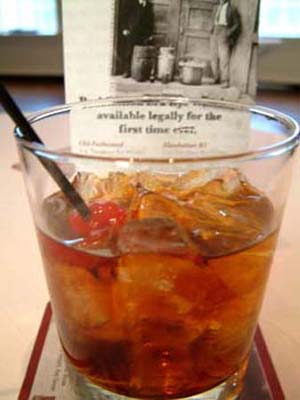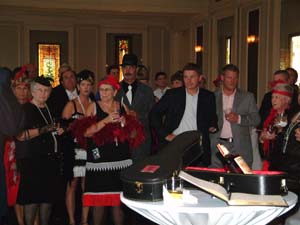Appleton Rum and Templeton Rye: Two New Liquors In The Chicago Market
By Caroline Clough in Arts & Entertainment on Aug 27, 2007 6:00PM

 Throughout our time writing for Chicagoist, we have been lucky enough to go to many a special event. From food expos to chocolate and wine tastings, we have had the opportunity to see a side of food commerce that many never do. We think it's a pretty good and interesting side. Its main purpose, as we see it, is to get the word about a new product out to the masses. The best way to achieve that purpose is to throw some kind of party and invite people who write about food and beverages or work in the food and drink industries to attend. We're always grateful for the invitations because it inevitably leads to free tastes of the product and, often enough, appetizers! More importantly, we usually learn a thing or two. For example, this past Thursday we went to Nacional 27 to taste Appleton Rum's Reserve blend and learned more about the general rum blending process than we thought possible. We were even given the chance to blend our own rum. In addition to the rum event we also got to go to The Chicago History Museum for an event celebrating Templeton Rye Whiskey and had the opportunity to learn a bit about one small town in Iowa and how its history inspired a whiskey. Or, rather, how history led to the creation of of a whiskey.
Throughout our time writing for Chicagoist, we have been lucky enough to go to many a special event. From food expos to chocolate and wine tastings, we have had the opportunity to see a side of food commerce that many never do. We think it's a pretty good and interesting side. Its main purpose, as we see it, is to get the word about a new product out to the masses. The best way to achieve that purpose is to throw some kind of party and invite people who write about food and beverages or work in the food and drink industries to attend. We're always grateful for the invitations because it inevitably leads to free tastes of the product and, often enough, appetizers! More importantly, we usually learn a thing or two. For example, this past Thursday we went to Nacional 27 to taste Appleton Rum's Reserve blend and learned more about the general rum blending process than we thought possible. We were even given the chance to blend our own rum. In addition to the rum event we also got to go to The Chicago History Museum for an event celebrating Templeton Rye Whiskey and had the opportunity to learn a bit about one small town in Iowa and how its history inspired a whiskey. Or, rather, how history led to the creation of of a whiskey.
First off we'd like to say that we consider ourselves intermediate amateurs in the world of wine and liquor tasting. In other words, we can differentiate between a mediocre and a fantastic wine or spirit but we couldn't necessarily tell you all that much about their flavor profiles. To that end, we're like the majority of drinkers throughout Chicago ... we're kind of like you (unless, of course, you're a master sommelier or a liquor distributor). So, imagine sitting down in front of nine glasses of rum and getting a Power Point presentation explaining the differences between them. A presentation made by none other than the master blender of the many versions of rum right in front of you, Joy Spence. Spence took us through the many variables and steps that it takes for her company to go from sugar cane to finished rum product. Of course, she was focusing on what made her product unique (and there were quite a few things) but through her talk we learned many things about rum in general.
Until this event we never really considered drinking rum straight up. It's not our favorite spirit and we guess we still associate it with a certain kind of girl in high school ... the malibu and coke kind of girl. But Spence's product, and others of its ilk we're sure, was made to be multi-purposeful: it's good enough to drink straight up but complex enough to hold its own against any kind of mixer you might throw at it. Taking a sip of Appleton Estate's Reserve had more similarities to taking a sip of good scotch (or even cognac) than we suspected. Through Spence's talk we learned that the concept of "terroir" doesn't only apply to vineyards, that the location and soil quality where one grows the sugar cane absolutely influences the finished product. Of course, Appleton Estate boasts that its cane is grown in Jamaica's "Cockpit Country", home of one of the very few Karst formations in the world. This unique landscape provides extremely fertile soil for sugar cane to grow and leads to, according to Spence, a richer final product. The tasting of the rum was different than any other tasting Chicagoist has taken part in. It wasn't simply smelling and tasting different final products from the same company but smelling and, eventually, tasting the different stages rum goes through before it becomes a final product. We nosed, but did not taste, un-aged column and pot still rums and got to compare them to aged ones. We were rather pleased that we could pick up the differences and found the variations in bouquets surprising. Also educational was Spence's explanation of the two different systems of creating 'age statements' for rum. According to Spence her company follows British aging laws which means that if a bottle says it's 12 years old that means that the youngest blend of rum in the bottle is 12 years old. In other countries the age on the bottle is an average of all the different blends put together. In other words: a bottle of rum from some South American countries (Spence's example) that says it's 25 years old is really made up of, perhaps, one or two parts rum that old or older but that the majority of the liquor is actually quite a bit younger. Who knew? We didn't.
At the end of the presentation we were given four bottles of different blended rums and instructed to create our own final product for a chance of going home with a bottle of the real thing (whether the V/X, Reserve or 12 year). Chicagoist is sad to say that our own mixture (we went for a sweet and subtle taste with just a bit of bite) didn't pass Spence's nose and taste test, and the only bottle we went home with was the small one we created.
The rum event itself was a bit formal. The twelve guests sat around a circular table in the back dining area of Nacional 27 in almost complete silence and once the presentation and official tasting were over, half of the guests left. Those of us who remained were given the opportunity to talk more with Spence while trying Appleton Reserve in mojito form (yummy) and a few of the restaurant's appetizers (our favorites were the lamb tacos and the shrimp and scallop ceviche). It was clear that the purpose of the event was to encourage distributors to carry the product and the atmosphere reflected that business-like purpose. It was a successful and educational event that we enjoyed participating in. We simply found it interesting, after attending Templeton Rye's similarly motivated tasting a few days later, to compare the different approaches to introducing and marketing a liquor.
Templeton Rye Whiskey is a new brand that has, until now, only been distributed in Iowa. One of its biggest talking points is its history and the event we attended played that up in a major way. What history, you may ask? Well, Templeton Rye -in the days of prohibition- was called "the good stuff" by many and brought by the truckload into Chicago by none other than Al Capone. The whiskey was made (at great personal risk) by farmers in Templeton, Iowa in an effort to support their farms and families during the economically stressful times of the 1920s and 30s. After prohibition ended the recipe persevered, passed from father to son and made in fewer batches and for a smaller (very, very much smaller) market. The location, then, for Templeton Rye's big Chicago reveal was fitting. The Chicago History Museum's upper and back floors, complete with stained glass windows, three piece band, two bars and veranda were properly speakeasy-like. The atmosphere of the event was markedly different from Appleton Estate's, there was a larger crowd and many of the guests had taken a long bus ride from Templeton to attend. The majority of the Templeton crowd were decked out in appropriately vintage flapper dresses and vertically striped suits (some with spats, some without) and they all seemed extremely happy to be there.


Chicagoist tried the whiskey first in a Manhattan and found it quite drinkable, though the lack of bitters was slightly perplexing to us (we assume this was an oversight of the bartender). We also tried the drink straight and found that it was as smooth as its press release said it was. We found it to be a bit sweeter than many a whiskey, a bit like bourbon in fact, and attribute its slightly sweeter taste to the fact that it is made with rye. At one point, after a few speeches and rounds of applause, a good number of us were out on the back veranda, sipping away, when we heard a loud wail and a booming voice informing us that we were about to be "raided". Coming out of the foliage and quickly approaching the stairs were two coppers. Well, two actors dressed up in period policemen's outfits and threatening the crowd with billy sticks and handcuffs. It was a little cheesy but the cheese factor was lessened by the sheer enthusiasm of the guests. What could have been over kill was just right. Time went on and there was singing and dancing, laughing and hugging. People were having a good time while enjoying the history and taste of Templeton Rye. We didn't learn as much about the science of the whiskey but we did learn a lot about its spirit.
Both Appleton Estates and Templeton Rye are just beginning to distribute their products in Chicago and we think each has its merits, taste-wise. They also seem to be in the same general pricing market. A bottle of Appleton Estate's Reserve rum is approximately $27 per bottle while a bottle of Templeton Rye is about $32.